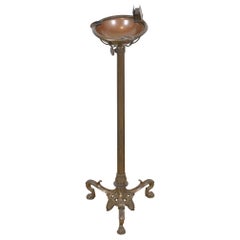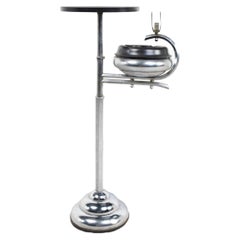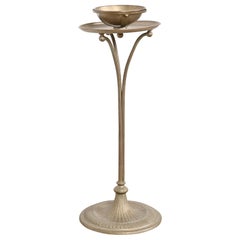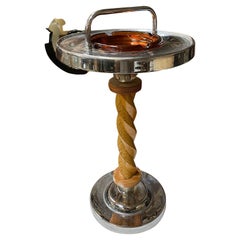Ashtrays
Early 20th Century American Art Deco Ashtrays
Bronze
1930s Belgian Art Deco Vintage Ashtrays
Chrome
1920s German Art Deco Vintage Ashtrays
Metal
Early 20th Century French Ashtrays
Ceramic
Early 20th Century American Art Deco Ashtrays
Silver
1930s Vintage Ashtrays
Metal
Early 20th Century Japanese Japonisme Ashtrays
Ceramic, Paint
Early 20th Century European Bauhaus Ashtrays
Bronze, Nickel
1930s Italian Art Deco Vintage Ashtrays
Murano Glass
1930s French Art Deco Vintage Ashtrays
Bronze
1930s American Vintage Ashtrays
Steel
1930s Italian Mid-Century Modern Vintage Ashtrays
Art Glass, Murano Glass
1920s American Art Deco Vintage Ashtrays
Metal
1930s Belgian Art Deco Vintage Ashtrays
Chrome
Early 20th Century French Ashtrays
Porcelain
Early 20th Century Czech Art Deco Ashtrays
Art Glass
Early 20th Century Czech Bohemian Ashtrays
Crystal
1930s Italian Art Deco Vintage Ashtrays
Murano Glass
Early 20th Century French Ashtrays
Bronze
Early 20th Century Austrian Art Deco Ashtrays
Marble
1930s Italian Art Deco Vintage Ashtrays
Murano Glass
1930s American Vintage Ashtrays
Spelter
1930s French Art Deco Vintage Ashtrays
Crystal
1930s French Art Deco Vintage Ashtrays
Wood
1930s Italian Art Deco Vintage Ashtrays
Silver, Gold
1920s French Art Nouveau Vintage Ashtrays
Brass
Early 20th Century French Other Ashtrays
Glass
1920s Austrian Art Deco Vintage Ashtrays
Nickel
1930s Italian Art Deco Vintage Ashtrays
Murano Glass
Early 20th Century Austrian Art Deco Ashtrays
Onyx, Bronze
1920s Italian Art Deco Vintage Ashtrays
Murano Glass
1930s Italian Art Deco Vintage Ashtrays
Gold
1930s Italian Art Deco Vintage Ashtrays
Murano Glass
Early 20th Century American Art Deco Ashtrays
Silver
1930s Italian Art Deco Vintage Ashtrays
Murano Glass
1930s Italian Art Deco Vintage Ashtrays
Murano Glass
1930s Italian Art Deco Vintage Ashtrays
Murano Glass
1930s Czech Mid-Century Modern Vintage Ashtrays
Glass
1930s Austrian Mid-Century Modern Vintage Ashtrays
Brass
Early 1900s American Arts and Crafts Antique Ashtrays
Bronze
1920s Italian Art Deco Vintage Ashtrays
Murano Glass
1920s Italian Art Deco Vintage Ashtrays
Murano Glass
1930s Italian Art Deco Vintage Ashtrays
Murano Glass
1930s Italian Art Deco Vintage Ashtrays
Murano Glass
1930s Italian Art Deco Vintage Ashtrays
Murano Glass
1920s Italian Art Deco Vintage Ashtrays
Murano Glass
1930s Italian Art Deco Vintage Ashtrays
Murano Glass
1930s Italian Art Deco Vintage Ashtrays
Murano Glass
1930s Italian Art Deco Vintage Ashtrays
Murano Glass
1930s Italian Art Deco Vintage Ashtrays
Murano Glass
1930s Italian Art Deco Vintage Ashtrays
Gold
1930s Italian Art Deco Vintage Ashtrays
Murano Glass
1930s French Art Deco Vintage Ashtrays
Glass
1930s Italian Art Deco Vintage Ashtrays
Gold
1930s Italian Art Deco Vintage Ashtrays
Murano Glass
1930s Italian Art Deco Vintage Ashtrays
Murano Glass
Early 20th Century French Mid-Century Modern Ashtrays
Metal
1930s Italian Art Deco Vintage Ashtrays
Murano Glass
Antique, New and Vintage Ashtrays
Once a near-universal tabletop accessory, many antique, new and vintage ashtrays have taken on an entirely new purpose in today’s homes.
Whereas these formerly ubiquitous objects were associated with smoking, drinking, gambling and other vices, a well-designed and interesting ashtray is a candy dish, coaster or cocktail garnish receptacle in today’s interiors. But don’t discount its initial function. Amid your carefully curated coastal chic California decor, for example, a stone ashtray can help you manage the ashes that accumulate while you’re burning your morning incense. Old glass ashtrays, which are quite popular and easily found in free-form, organic shapes, can be a purely decorative final touch when styling a coffee table, whether you’ve filled it with wrapped lemon-drop candies or not.
In the postwar years, the democratization of luxury led to an explosion in the number of well-designed ashtrays, and there are many mid-century modern ashtrays to choose from on 1stDibs. (It’s no coincidence that sculptor Isamu Noguchi devised his “Dymaxion” version, which he hoped would make him rich, in 1945. Alas, it turned out to be too difficult to mass-produce.) The design collection of the Museum of Modern Art includes ashtrays by Carlo Scarpa (Murano glass, 1950–59); Achille Castiglioni (stainless steel with spring-like inserts, 1970); Masayuki Kurokawa (rubber and steel, 1973) and more. Smoking declined in popularity in the 1970s and ’80s, after the surgeon general’s warning began appearing on cigarette packs, but designers were still crafting ashtrays through the end of the century (especially outside the United States).
On 1stDibs, browse a collection of antique, new and vintage ashtrays that includes everything from modern and minimalist cigar ashtrays to outwardly ornate Art Deco ashtrays that evoke the opulence and elegance of the 1920s.



